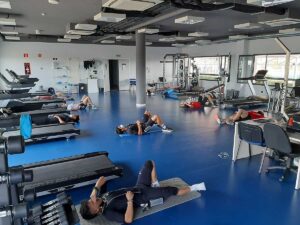Introduction
Electrostimulation (EMS) is a method of close training that is mainly used in strength training. On the other hand, no studies have been conducted to date on resistance performance and its metabolic and cardiorespiratory adaptations related to local electrostimulation during cycling. For this, a 4-week training period was designed with two groups; one with electrostimulation and one without electrostimulation. The hypothesis of this study is that the group with electrostimulation results in greater aerobic and anaerobic adaptations than the group without electrostimulation. Also, there is speculation about strength gains within the group with EMS compared to the group without EMS.
Method
21 healthy and untrained students specifically in sports participated in this study, in which 10 subjects conducted the training without EMS and 11 subjects the EMS training.
These subjects were distributed randomly in the training groups. One week before the test, the subjects became familiar with the test procedures and with the application of EMS in a cycloergometer for two consecutive days. Once the two days of familiarization were completed, 6 days of recovery were left. After that recovery period, the subjects conducted 14 training sessions over a period of 4 weeks. The training consisted of a 60 min activity in 60% cycloergometer of the peak power with or without EMS. This intensity was aimed at avoiding progressive recruitment of type II fibers as in the case of higher exercise intensities. After four weeks of training, 10 days of recovery were left before final testing.
The electrostimulation protocol used during the test was a frequency of 80 Hz with a pulse width of 400 µs and a dutty cycle of 10 seconds of electrical impulse and 2 seconds of rest. The electrodes were placed only in the lower limbs.
Results
During the training process, CK and lactate levels were significantly higher in the group with EMS compared to the group without EMS. On the other hand, only a slight metabolic and respiratory increase was observed during the exercise load in the EMS group. However, statistically there was no significant improvement in metabolic and cardiorespiratory adaptations in the EMS group compared to the group without EMS.
Conclusion
Una de las principales limitaciones del estudio está asociada con el limitado reclutamiento espacial de las fibras musculares tipo I y II durante el EMS, que es bastante superficial y parcialmente incompleta. In addition, the EMS protocol that was followed in this study was too aggressive and therefore there were high levels of muscle damage. However, there were no negative effects on the perception of physical condition, flexibility, energy and health, which shows that EMS is a very safe tool, as long as it is used with common sense.
Bibliography
T.Link., W.Bloch., S.Matches et al. (2017). Chronic effects of superimposed electromyostimulation during cycling on aerobic and anaerobic capacity. European Journal of Applied Physiology 117:881–892







